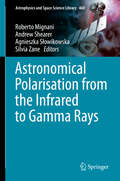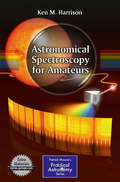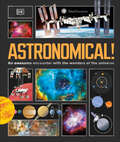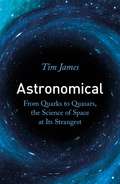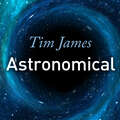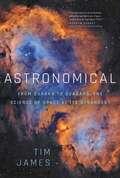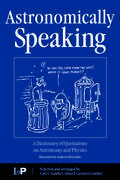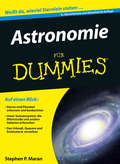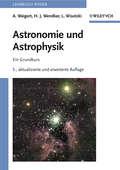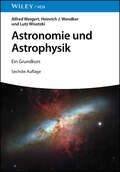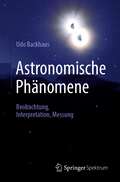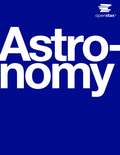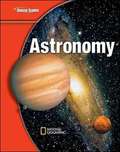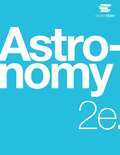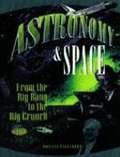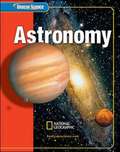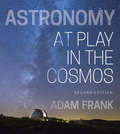- Table View
- List View
Astronomical Photometry: Past, Present, and Future (Astrophysics and Space Science Library #373)
by Eugene F. Milone C. SterkenThis book will bring together experts in the field of astronomical photometry to discuss how their subfields provide the precision and accuracy in astronomical energy flux measurements that are needed to permit tests of astrophysical theories. Differential photometers and photometry, improvements in infrared precision, the improvements in precision and accuracy of CCD photometry, the absolute calibration of flux, the development of the Johnson UBVRI photometric system and other passband systems to measure and precisely classify specific types of stars and astrophysical quantities, and the current capabilities of spectrophotometry, and polarimetry to provide precise and accurate data, will all be discussed in this volume. The discussion of `differential' or `two-star' photometers will include those developed for planetary as well as stellar photometry and will range from the Princeton polarizing photometer through the pioneering work of Walraven to the differential photometers designed to measure the ashen light of Venus and to counter the effects of aurorae at high latitude sites; the last to be discussed will be the Rapid Alternate Detection System (RADS) developed at the University of Calgary in the 1980s.
Astronomical Polarisation from the Infrared to Gamma Rays (Astrophysics and Space Science Library #460)
by Silvia Zane Roberto Mignani Andrew Shearer Agnieszka SłowikowskaThis book serves as both a primer to astronomical polarimetry and an authoritative overview of its application to various types of astronomical objects from AGN, compact stars, binary systems, stars across the HR diagram, transients, the interstellar medium and solar system bodies. It starts with an historical perspective, a discussion of polarimetric theory, instrumentation and techniques in wave bands from the near infrared to gamma rays. The book presents the state of the art in astronomical polarimetry. It is motivated by the new X-ray polarimeters due to be launched in the next four years and improved optical polarimeters on large telescopes requiring a new analysis of polarimetric theory, methodology and results.This book will be suitable as advanced undergraduate companion text, a primer for graduate students and all researchers with an interest in astronomical polarimetry.
Astronomical Spectroscopy for Amateurs (The Patrick Moore Practical Astronomy Series)
by Ken M. HarrisonAstronomical Spectroscopy for Amateurs is a complete guide for amateur astronomers who are looking for a new challenge. After a brief overview of the development of spectroscopes and an introduction to the theory of stellar spectra, the book goes on to examine the various types of spectroscopes available to amateurs. Next, practical sections address all aspects of setting-up and using various types of commercially-available and home-built spectroscopes. A final part gives detailed instructions for the design and construction of three different spectroscopes, along with the necessary design theory (minimal math). The home-made spectroscopes have performance capabilities near or equal to commercial units but are constructed using basic hand tools for a fraction of the cost! This up-to-date practical spectroscopy book will enable amateur astronomers to develop the skills and equipment needed to prepare scientifically acceptable spectra data, and to make a valuable contribution to ProAm projects.
Astronomical!: An Awesome Encounter with the Wonders of the Universe
by DKAn awesome encounter with the wonders of the Universe.Behold a cosmic treasure trove of spectacular photographs that captures space as you've never seen it before in this space book for children aged 9+.Mind-blowing new images made possible by the latest technology can now take us to the heart of the Universe–from swirling dust devils on Mars, to emerging stars in nebulas, supermassive storms on Jupiter, as well as galaxies, comets, asteroids, and much more.This space book for children offers: Fast facts and amazing stats that highlight the mind-blowing wonders of the Solar System and the Universe.A collection of spectacular images captured by the latest space telescope, the James Webb, as well as mesmerizing images from Hubble and other spacecraft.Content endorsed and authenticated by Smithsonian.Astronomical! is the perfect gift to inspire young stargazers and astronomers. Every double page features a magnificent celestial body alongside fascinating and informative text that brings to life the wonder of outer space. Additional facts and comparisons provide readers with key information at a glance.
Astronomical: From Quarks to Quasars, the Science of Space at its Strangest
by Tim James'In the same light-heartedly informative spirit as his previous Elemental, Tim James gives us an entertaining gallop through light years of space science, from the big bang to UFOs'Andrew Crumey, author of The Great Chain of UnbeingPRAISE FOR THE AUTHOR'Humorous, yet deep . . . Fundamental will speak to all readers' Professor Charles Antoine, Sorbonne University'Who said science was dry? Certainly not Tim James' New York PostDoes the Big Bang prove the existence of God? What's the Universe expanding into? Is Earth the only planet which supports life? Why did the greatest astronomer in history murder his pet moose?Space is the biggest, oldest, hottest, coldest, strangest thing a human can study. It's no surprise then, that the weirdest facts in science (not to mention the weirdest scientists themselves) are found in astrophysics and cosmology. If you're looking for instructions on how to set up your grandad's telescope this book probably isn't for you. In Astronomical, Tim James takes us on a tour of the known (and unknown) Universe, focusing on the most-mind boggling stuff we've come across, as well as unpacking the latest theories about what's really going on out there.Guiding us through Einstein's relativity, quantum mechanics and string theory, Astronomical delves into the baffling corners of the cosmos and tackles the biggest mysteries we face: from alien life to the zodiac; from white holes to wormholes; from quasars to quark stars. This is the science of space at its absolute strangest! From the creation of the Universe out of nothing to the Large Hadron Collider and the Universe's ongoing expansion, Tim explores our planetary neighbours, where it snows metal on Venus, there are underground lakes on Mars and rivers of petrol on Titan. He then looks beyond our solar system: to exoplanets which could support life, rogue planets, quark stars, quasars, neutron stars and more. Tim looks at black holes (and how to survive in one), wormholes, white holes as well as dark energy, dark matter and even a bit of string theory thrown in for good measure. He explains the search for extra-terrestrial intelligence, including the discovery of Martian fossils in the Alan Hills meteorite and the tantalising 'Wow signal' transmission earth received in 1973 - still unexplained. He also rebuts resurgent anti-science movements, including the Flat Earth Society and discusses what's really going on inside Area 51.To close, Tim finishes by looking at human achievements in space including how rockets work, how faster-than-light warp-drives (currently being investigated by NASA) work and how we plan to colonise both the moon and Mars.
Astronomical: From Quarks to Quasars, the Science of Space at its Strangest
by Tim James'In the same light-heartedly informative spirit as his previous Elemental, Tim James gives us an entertaining gallop through light years of space science, from the big bang to UFOs'Andrew Crumey, author of The Great Chain of UnbeingPRAISE FOR THE AUTHOR'Humorous, yet deep . . . Fundamental will speak to all readers' Professor Charles Antoine, Sorbonne University'Who said science was dry? Certainly not Tim James' New York PostDoes the Big Bang prove the existence of God? What's the Universe expanding into? Is Earth the only planet which supports life? Why did the greatest astronomer in history murder his pet moose?Space is the biggest, oldest, hottest, coldest, strangest thing a human can study. It's no surprise then, that the weirdest facts in science (not to mention the weirdest scientists themselves) are found in astrophysics and cosmology. If you're looking for instructions on how to set up your grandad's telescope this book probably isn't for you. In Astronomical, Tim James takes us on a tour of the known (and unknown) Universe, focusing on the most-mind boggling stuff we've come across, as well as unpacking the latest theories about what's really going on out there.Guiding us through Einstein's relativity, quantum mechanics and string theory, Astronomical delves into the baffling corners of the cosmos and tackles the biggest mysteries we face: from alien life to the zodiac; from white holes to wormholes; from quasars to quark stars. This is the science of space at its absolute strangest! From the creation of the Universe out of nothing to the Large Hadron Collider and the Universe's ongoing expansion, Tim explores our planetary neighbours, where it snows metal on Venus, there are underground lakes on Mars and rivers of petrol on Titan. He then looks beyond our solar system: to exoplanets which could support life, rogue planets, quark stars, quasars, neutron stars and more. Tim looks at black holes (and how to survive in one), wormholes, white holes as well as dark energy, dark matter and even a bit of string theory thrown in for good measure. He explains the search for extra-terrestrial intelligence, including the discovery of Martian fossils in the Alan Hills meteorite and the tantalising 'Wow signal' transmission earth received in 1973 - still unexplained. He also rebuts resurgent anti-science movements, including the Flat Earth Society and discusses what's really going on inside Area 51.To close, Tim finishes by looking at human achievements in space including how rockets work, how faster-than-light warp-drives (currently being investigated by NASA) work and how we plan to colonise both the moon and Mars.
Astronomical: From Quarks to Quasars, the Science of Space at its Strangest
by Tim James'In the same light-heartedly informative spirit as his previous Elemental, Tim James gives us an entertaining gallop through light years of space science, from the big bang to UFOs'Andrew Crumey, author of The Great Chain of UnbeingPRAISE FOR THE AUTHOR'Humorous, yet deep . . . Fundamental will speak to all readers' Professor Charles Antoine, Sorbonne University'Who said science was dry? Certainly not Tim James' New York PostDoes the Big Bang prove the existence of God? What's the Universe expanding into? Is Earth the only planet which supports life? Why did the greatest astronomer in history murder his pet moose?Space is the biggest, oldest, hottest, coldest, strangest thing a human can study. It's no surprise then, that the weirdest facts in science (not to mention the weirdest scientists themselves) are found in astrophysics and cosmology. If you're looking for instructions on how to set up your grandad's telescope this book probably isn't for you. In Astronomical, Tim James takes us on a tour of the known (and unknown) Universe, focusing on the most-mind boggling stuff we've come across, as well as unpacking the latest theories about what's really going on out there.Guiding us through Einstein's relativity, quantum mechanics and string theory, Astronomical delves into the baffling corners of the cosmos and tackles the biggest mysteries we face: from alien life to the zodiac; from white holes to wormholes; from quasars to quark stars. This is the science of space at its absolute strangest! From the creation of the Universe out of nothing to the Large Hadron Collider and the Universe's ongoing expansion, Tim explores our planetary neighbours, where it snows metal on Venus, there are underground lakes on Mars and rivers of petrol on Titan. He then looks beyond our solar system: to exoplanets which could support life, rogue planets, quark stars, quasars, neutron stars and more. Tim looks at black holes (and how to survive in one), wormholes, white holes as well as dark energy, dark matter and even a bit of string theory thrown in for good measure. He explains the search for extra-terrestrial intelligence, including the discovery of Martian fossils in the Alan Hills meteorite and the tantalising 'Wow signal' transmission earth received in 1973 - still unexplained. He also rebuts resurgent anti-science movements, including the Flat Earth Society and discusses what's really going on inside Area 51.To close, Tim finishes by looking at human achievements in space including how rockets work, how faster-than-light warp-drives (currently being investigated by NASA) work and how we plan to colonise both the moon and Mars.
Astronomical: From Quarks to Quasars: The Science of Space at its Strangest
by Tim JamesGuiding us through Einstein's theory of relativity, quantum mechanics, and string theory, Astronomical explains the baffling mysteries of the cosmos: from alien life to the zodiac; from white holes to wormholes; from quasars to quark stars—all within a narrative that is as entertaining as it is edifying.Does the Big Bang prove the existence of God? What's the Universe expanding into? Is Earth the only planet which supports life? Space is the biggest, oldest, hottest, coldest, strangest thing a human can study. It's no surprise then, that the weirdest facts in science (not to mention the weirdest scientists themselves) are found in astrophysics and cosmology. If you're looking for instructions on how to set up your grandad's telescope this book probably isn't for you. In Astronomical, Tim James takes us on a tour of the known (and unknown) universe, focusing on the most-mind boggling stuff we've come across, as well as unpacking the latest theories about what's really going on out there. Guiding us through Einstein's relativity, quantum mechanics and string theory, Astronomical delves into the baffling corners of the cosmos and tackles the biggest mysteries we face: from alien life to the zodiac; from white holes to wormholes; from quasars to quark stars. This is the science of space at its absolute strangest.
Astronomically Speaking: A Dictionary of Quotations on Astronomy and Physics
by Carl C. Gaither Alma E. Cavazos-GaitherTo understand the history, accomplishments, failures, and meanings of astronomy requires a knowledge of what has been said about astronomy by philosophers, novelists, playwrights, poets, scientists, and laymen. Astronomically Speaking: A Dictionary of Quotations on Astronomy and Physics serves as a guide to what has been said about astronomy through the ages, from the past to the present. Containing approximately 1,550 quotations and numerous illustrations, this resource is the largest compilation of astronomy and astrophysics quotations published to date. A quick glance through the table of contents illustrates the variety of topics discussed. Readers can quickly and easily access the wit and wisdom of several hundred scientists, writers, philosophers, poets, and academics using the comprehensive indexes.
Astronomie für Dummies (Für Dummies)
by Stephen P. MaranFinden auch Sie die Weiten des Kosmos faszinierend und fragen sich, wie Wissenschaftler so viel über Objekte in unerreichbarer Ferne wissen können? "Astronomie für Dummies" bringt Ihnen die Weiten des Universums näher: Erkunden Sie unser Sonnensystem, ferne Galaxien und die Milchstraße. Lesen Sie wie in einem Krimi von schwarzen Löchern, dem Asteroidengürtel und der Entstehung des Universums. Außerdem gibt Stephen Maran viele Tipps zur richtigen Ausrüstung eines Astronomen. So können Sie schon bald selbst nach den Sternen greifen.
Astronomie für Dummies (Für Dummies)
by Stephen P. MaranFinden auch Sie die Weiten des Kosmos faszinierend und fragen sich, wie Wissenschaftler so viel über Objekte in unerreichbarer Ferne wissen können? "Astronomie für Dummies" bringt Ihnendas Universum näher: Erkunden Sie unser Sonnensystem, ferne Galaxien und die Milchstraße. Lesen Sie wie in einem Krimi von schwarzen Löchern, dem Asteroidengürtel und der Entstehung des Universums. Außerdem gibt Stephen Maran viele Tipps zur richtigen Ausrüstung eines Astronomen. So können Sie schon bald selbst nach den Sternen greifen.
Astronomie und Astrophysik: Ein Grundkurs
by Alfred Weigert Heinrich J. Wendker Lutz WisotzkiDieses Lehrbuch ist ein Grundkurs im besten Sinne: Beginnend mit den physikalischen und technischen Grundlagen, die fur das Verstandnis der weiteren astrophysikalischen Ausfuhrungen benotigt werden, vermittelt es solides Wissen fur die moderne Astrophysik, ist klar geschrieben, reich bebildert und auch in den mathematischen Teilen jederzeit verstandlich. Nun liegt das Buch in der 5. Aufl age vor - vollstandig aktualisiert und um das Kapitel Extrasolare Planetensysteme erweitert von Lutz Wisotzki, der bereits die letzte Aufl age mit verantwortete. Studenten der Physik und Astronomie im Grundstudium wie auch Fachleute und Amateure schatzen dieses Buch fur Schule, Studium und Freizeit.
Astronomie und Astrophysik: Ein Grundkurs
by Alfred Weigert Heinrich J. Wendker Lutz WisotzkiDer Klassiker zum Einstieg in die Astronomie und Astrophysik Die sechste Auflage dieses Lehrbuchs ist der ideale Einstieg für alle, die sich auf Universitätsniveau mit Astronomie und Astrophysik beschäftigen möchten. Dank der klaren Sprache, der reichen Bebilderung und der Beschränkung auf die notwendigste Mathematik ist es unvergleichlich verständlich und vermittelt so ein umfangreiches astronomisches und astrophysikalisches Grundwissen. Die vorliegende sechste Auflage ist eine umfassende Neugestaltung, die weit über die Aktualisierung einzelner Abschnitte hinausgeht: komprimierter Abriss physikalischer Grundlagen am Anfang des Buchesneues Kapitel „Erde und Mond“kondensiertere Darstellung der Sternphysikneues Kapitel „Entstehung und Entwicklung von Galaxien“überarbeitete und neue Abbildungenneue Aufgaben Damit stellt das Buch die etablierte Grundlage gesicherten Wissens dar und ermöglicht zugleich die Teilhabe an den atemberaubenden Erkenntnisfortschritten in der aktuellen astrophysikalischen Forschung.
Astronomische Phänomene: Beobachtung, Interpretation, Messung
by Udo BackhausDieses Buch behandelt astronomische Phänomene und Beobachtungsmöglichkeiten für astronomisch interessierte Laien, Lehrkräfte und Schülerinnen und Schüler: Ist die Erde wirklich eine Kugel? Zu welchen Gedanken kann die Beobachtung eines Sonnenunterganges oder einer Mondfinsternis anregen? Wie bewegen sich die Sonne und die Planeten über den Himmel, und welche Schlüsse lassen sich daraus ziehen? Der Autor skizziert auch Messungen und Beobachtungen, die man alleine oder in einer Gruppe durchführen kann beispielsweise die Bestimmung des Erdradius‘ oder die Entfernung zum Mond. Einige der Projekte können an einem oder mehreren Tagen oder Nächten durchgeführt werden, andere erstrecken sich über einen längeren Zeitraum. Auch internationale Projekte, bei denen Schulen, Amateurastronomen und Profis kooperieren, werden beschrieben. Mit einer Fülle an astronomischen Phänomenen und Beobachtungsmöglichkeiten richtet sich das Buch sowohl an Studierende und Lehrkräfte der Astronomie und Physik als auch an Hobbyastronominnen und -astronomen, die mehr über astronomische Phänomene erfahren und die zugrundeliegenden Erklärungen verstehen wollen. Der Autor motiviert zu Versuchen, „eigene“ Messwerte zu erhalten und auszuwerten, und zeigt am Beispiel der Astronomie, wie Wissenschaft funktioniert.
Astronomy
by David Morrison Andrew Fraknoi Sidney C. Wolff"Astronomy is designed to meet the scope and sequence requirements of one- or two-semester introductory astronomy courses. The book begins with relevant scientific fundamentals and progresses through an exploration of the solar system, stars, galaxies, and cosmology. The Astronomy textbook builds student understanding through the use of relevant analogies, clear and non-technical explanations, and rich illustrations. Mathematics is included in a flexible manner to meet the needs of individual instructors"-
Astronomy
by Anita YasudaHead outside and look up. What do you see? At night you might see stars, the moon, the Milky Way, and planets! During the day all these things will still be there, but they’ll be hidden by the bright light of the sun. Astronomy is the study of celestial objects and what’s beyond the nebulous boundaries of space. In Astronomy: Cool Women in Space, young readers will be inspired by stories of women who have made great strides in a field that takes courage, persistence, and creativity to pursue. Most people have heard of Carl Sagan and Stephen Hawking, but have you heard of Maria Mitchell or Caroline Herschel? For many decades, female astronomers have been defining the field by making discoveries that changed the human relationship with space. Astronomy: Cool Women in Space will introduce young readers to three women who are bringing the science of astronomy forward and inspiring the next generation of astronomers. The primary sources, essentials questions, and knowledge connections within Astronomy: Cool Women in Space encourage both boys and girls to explore our celestial world while being inspired to ask what role they might play in the next discovery.
Astronomy
by Glencoe Mcgraw-HillDiscover the Flexibility to Teach Science Your Way!. "Glencoe Science: Astronomy," a module in the Glencoe Science 15 book series, provides students with accurate and comprehensive coverage of middle school National Science Education Standards. Concepts are explained in a clear, concise manner, and are integrated with a wide range of hands-on experiences, critical thinking opportunities, real-world applications, and connections to other sciences and to non-science areas of the curriculum. Co-authored by National Geographic, unparalleled graphics reinforce key concepts. A broad array of print and technology resources help differentiate and accommodate all learners. The modular approach allows you to mix and match books to meet your specific curriculum needs.
Astronomy
by OpenStaxDesigned to meet the scope and sequence of your course, Astronomy 2e is written in clear non-technical language, with the occasional touch of humor and a wide range of clarifying illustrations. It has many analogies drawn from everyday life to help non-science majors appreciate, on their own terms, what our modern exploration of the universe is revealing. The book can be used for either a one-semester or two-semester introductory course. <p><p>The second edition has been updated according to new exploration and discoveries. The second edition also includes a significant amount of new art and images. The first edition of Astronomy by OpenStax is also available. <p><p>This is the official print version of this OpenStax textbook. OpenStax makes full-color hardcover and B&W paperback print copies available for students who prefer a hardcopy textbook to go with the free digital version of this OpenStax title. The textbook content is exactly the same as the OpenStax digital book. This textbook is available for free download at the OpenStax dot org website, but as many students prefer to study with hardcopy books, we offer affordable OpenStax textbooks for sale through Amazon as well as most campus bookstores.
Astronomy & Space: From the Big Bang to the Big Crunch (Volume 3, Q-Z)
by Phillis EngelbertFeatures include approximately 300 entries; approximately 240 illustrations; sidebars; a historical timeline of famous astronomers, events and discoveries; glossary of terms; and a cumulative index.
Astronomy (Boy Scouts of America Merit Badge Series)
by Boy Scouts of America StaffIn the Boy Scouts of America Merit Badge Series, you can learn about sports, crafts, science, trades, business, and future careers as you earn merit badges. There are more than 135 merit badges, and any Scout, or any qualified Venturer or Sea Scout may earn any of these at any time. In this book, you can find the Merit Badge Requirements of Astronomy.
Astronomy (Glencoe Science)
by Mcgraw-Hill Staff Glencoe McGraw-Hill StaffDiscover the flexibility to teach science your way Astronomy,as a part of the Glencoe Science 15-Book Series, provides students with accurate and comprehensive coverage of the solar system and beyond. The strong content coverage integrates a wide range of hands-on experiences, critical-thinking opportunities, and real-world applications. The modular approach allows you to mix and match books to meet your curricula.
Astronomy (Merit Badge Ser.)
by Boy Scouts of America StaffFundamentals of the requirements for pursuing a merit badge in astronomy.
Astronomy (Second Edition): At Play In The Cosmos
by Adam FrankTeach the process of science through the excitement of discovery The Second Edition of Adam Frank’s groundbreaking book supports the mission of helping students become scientifically educated citizens. He shows students that the process of science is a human endeavor by introducing them, via interviews, to scientists from across the field. New Anatomy of a Discovery features help students visualize the excitement of discovery. This purchase offers access to the digital ebook only.
Astronomy 101: From the Sun and Moon to Wormholes and Warp Drive, Key Theories, Discoveries, and Facts about the Universe (Adams 101 Series)
by Carolyn Collins PetersenExplore the curiosities of our galaxy with this comprehensive, digestible guide to astronomy!Too often, textbooks obscure the beauty and wonder of outer space with tedious discourse that even Galileo would oppose. Astronomy 101 cuts out the boring details and lengthy explanations, and instead, gives you a lesson in astronomy that keeps you engaged as you discover what's hidden beyond our starry sky. From the Big Bang and nebulae to the Milky Way and Sir Isaac Newton, this celestial primer is packed with hundreds of entertaining astronomy facts, charts, and photographs you won't be able to get anywhere else. So whether you&’re looking to unravel the mystery behind black holes, or just want to learn more about your favorite planets, Astronomy 101 has all the answers—even the ones you didn&’t know you were looking for.

